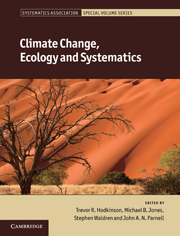Book contents
- Frontmatter
- Contents
- List of contributors
- Preface
- Section 1 Introduction
- Section 2 Adaptation, speciation and extinction
- Section 3 Biogeography, migration and ecological niche modelling
- 10 Biodiversity informatics for climate change studies
- 11 Climate envelope models in systematics and evolutionary research: theory and practice
- 12 Biogeography of Cyclamen: an application of phyloclimatic modelling
- 13 Cenozoic climate changes and the demise of Tethyan laurel forests: lessons for the future from an integrative reconstruction of the past
- 14 The impact of climate change on the origin and future of East African rainforest trees
- 15 Hybridisation, introgression and climate change: a case study of the tree genus Fraxinus (Oleaceae)
- Section 4 Conservation
- Index
- Systematics Association Publications
- Plate section
- References
13 - Cenozoic climate changes and the demise of Tethyan laurel forests: lessons for the future from an integrative reconstruction of the past
from Section 3 - Biogeography, migration and ecological niche modelling
Published online by Cambridge University Press: 16 May 2011
- Frontmatter
- Contents
- List of contributors
- Preface
- Section 1 Introduction
- Section 2 Adaptation, speciation and extinction
- Section 3 Biogeography, migration and ecological niche modelling
- 10 Biodiversity informatics for climate change studies
- 11 Climate envelope models in systematics and evolutionary research: theory and practice
- 12 Biogeography of Cyclamen: an application of phyloclimatic modelling
- 13 Cenozoic climate changes and the demise of Tethyan laurel forests: lessons for the future from an integrative reconstruction of the past
- 14 The impact of climate change on the origin and future of East African rainforest trees
- 15 Hybridisation, introgression and climate change: a case study of the tree genus Fraxinus (Oleaceae)
- Section 4 Conservation
- Index
- Systematics Association Publications
- Plate section
- References
Summary
Abstract
Climate on earth has always been changing. Despite decades of investigation, our limited knowledge of the ecological and evolutionary effects of climate changes often translates into uncertain predictions about the impact of future climates on biodiversity. Integrative biogeographical approaches using palaeobotanical, phylogenetic and niche-based species distribution models, when permitted by data availability, may provide valuable insights to address these key questions. Here we combine palaeobotanical and phylogeographical information with hindcast modelling of species distribution changes to reconstruct past range dynamics and differentiation in the bay laurel (Laurus spp., Lauraceae), an emblematic relict tree from the subtropical laurel forests that thrived in Tethyan realms during most of the Tertiary period. We provide plausible examples of climate-driven migration, extinction and persistence of populations and taxa, and discuss the factors that influence niche conservatism or adaptation to changing environments. Finally, we discuss the likely impacts of the predicted climate change on laurophyllous taxa in the Mediterranean and Macaronesia.
Introduction
The reconstruction of the evolutionary history and distribution of plants has been based primarily on the information supplied by two relatively independent research fields: palaeobotany and phylogenetics. More recently, it has also relied on statistical modelling approaches to hindcast species distributions on geological timescales. Palaeobotany has long relied on the description of fossils, the resolution power of microscopes and fossil sampling in cores. Isotope dating, and other approaches for absolute timing of events, then led to a methodological revolution in this field (Stewart and Rothwell, 1993).
- Type
- Chapter
- Information
- Climate Change, Ecology and Systematics , pp. 280 - 303Publisher: Cambridge University PressPrint publication year: 2011
References
- 9
- Cited by

